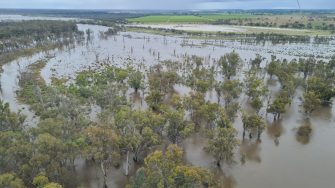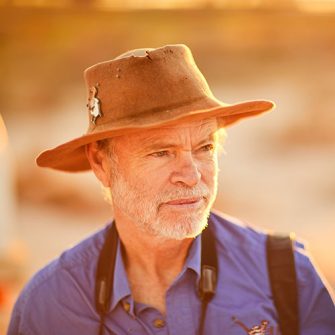
Date: Tuesday November 1st 2022
Project: Eastern Australian Waterbird Survey
Observers: Richard Kingsford & John Porter
Pilot: Tim Dugan
We got into the plane to take off early from Mildura under leaden skies with light drizzle. Not a good sign. Visibility was poor, making the prospects of finishing the survey today highly unlikely. It is always extremely challenging when faced with these visibility issues, primarily because of the low cloud, compounded by the rain. Thankfully when we got up to where the River Murray meets the Darling River at the NSW town of Wentworth, the clouds had lifted enough for us to have good visibility and we got on with the survey.
Junction of the River Murray and Darling River at Wentworth, with their differently coloured water.
Right here, it was interesting to see what had happened to Lock 10 on the River Murray at the town of Wentworth. It was submerged. The size of the flood meant that you couldn't see where the lock structure existed, apart from a ripple in the water.
The River Murray was flooding on both sides of the channel,
As we had seen upstream, the floodplain was extensively inundated. Many of the billabongs or oxbow lakes, because of their u-shapes, were flooded. It was sometimes difficult to even see their boundaries.
Like everywhere else there were very few waterbirds on the billabongs. Just a couple of black swans, cormorants and Australian shelduck.
Surveying one of the billabongs along the River Murray.
Surveying along the River Murray.
We surveyed all the way down the Murray river system until we got to the town of Berri. The team had done the first count of this part of the River Murray- the Lindsay-Wallpolla and Chowilla floodplain in the Riverland, the week before. This was the second count which we were finishing off.
One of the locks on the River Murray.
Another of the ‘drowned’ locks on the River Murray.
It was really interesting to see so much flooding across the usually white salty floodplains. Great to think much of this salt was dissolving and washing down through the system. Many of the floodplain trees were hanging on across the floodplain, with the flooding providing them with a life-supporting ‘drink’.
Large areas of the floodplain of the River Murray under water, with terrestrial areas green after the widespread rain.
Large previously dry floodplains were inundated across the Riverland areas of South Australia.
River Murray floodplain near the South Australian town of Berri.
Banrock Station Ramsar site on the Lower River Murray.
Widespread flooding across the Lower River Murray floodplain.
Then we headed for a part of the River Murray, just upstream of the Lower Lakes, where we regularly do another short survey. That's when we started to get into trouble with the weather.
Storm over the Lower River Murray.
A rolling band of thunderstorms meant that our straight line flight to the spot was no longer possible. We had to go around the thunderstorms.
Intensifying storms over the Lower River Murray.
Inevitably because of the widespread and ongoing thunderstorms, we had to discuss whether or not we could spend the night in Goolwa as planned. The prospect of hail and not having a plane protected by a hangar was an expensive risk. This can do significant damage.
We then surveyed the top end of Lake Alexandria.
The point where the River Murray (on the right) flows into Lake Alexandrina (left).
Surveying Lake Alexandrina for waterbirds.
There were the usual colonies of straw-necked ibis and pied cormorants. And lots of pairs of black swans with their broods. Lake Alexandria had a large pied cormorant colony, with Lake Albert supporting a few relatively small straw-necked ibis colonies.
Colony of pied cormorants on Lake Alexandrina.
It was surprising again how few waterbirds were around. Probably one of the lowest counts we've seen. Waterbirds are spoilt for choice at the moment in terms of habitat across Eastern Australia.
We managed to make it to Goolwa to refuel and reassess our survey prospects for the afternoon.
River Murray and Goolwa.
Thankfully there was enough of a break in the weather, still some light showers, to finish our circuits of Lake Alexandria and Lake Albert.
Surveying Lake Albert for waterbirds.
There were very few Australian shelduck, hardly any ducks, apart from a few black duck. There were also large flocks of cormorants, with many black swans with cygnets. It was a bouncy day with the wind blowing and we were happy to finish at the end of the day. We finished up for the night at Goolwa.

